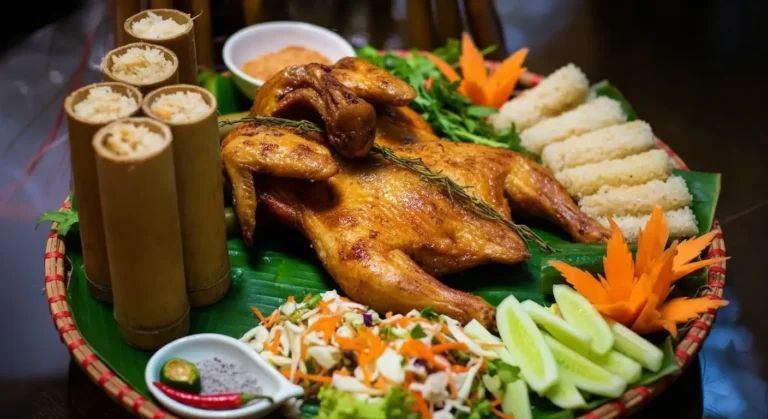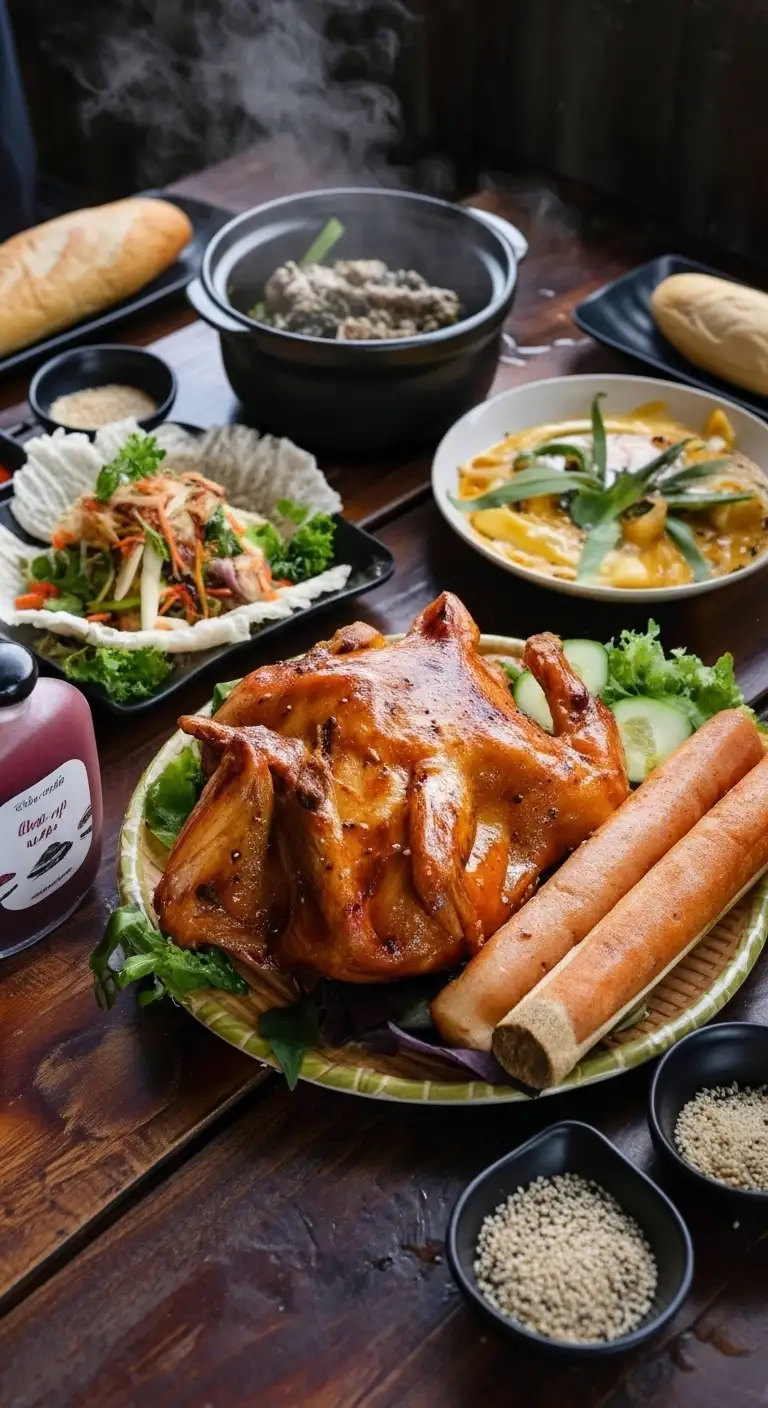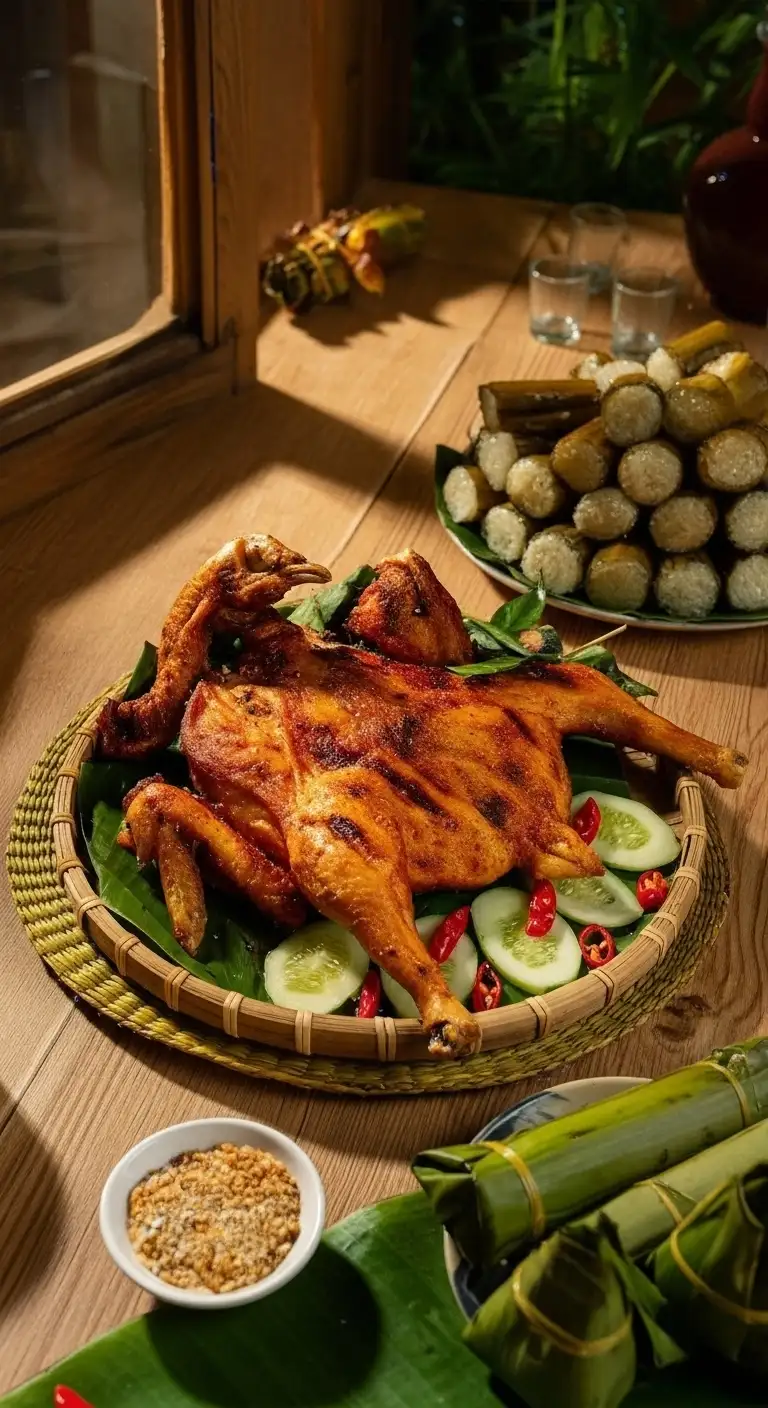Cơm Lam (pronounced “Kuhm Lahm”) is a unique and rustic Vietnamese dish that translates literally to “rice cooked in a bamboo tube.” It is a cultural staple of the ethnic minority groups, particularly the Thái people, residing in the mountainous regions of Northwest Vietnam and the Central Highlands.
This dish is not just food; it’s a traditional cooking method rooted in necessity. Historically, it was the perfect way for travelers, hunters, or farmers embarking on long journeys to cook rice easily without needing pots or pans. The result is an incredibly aromatic, sticky rice infused with the subtle, sweet fragrance of fresh bamboo—a true taste of Vietnam’s highland culture.

Cơm Lam: The Basics
The Core Ingredients:
Rice: Typically sticky rice (gạo nếp or glutinous rice) is used, as its high starch content helps the rice bind and hold its cylindrical shape.
Bamboo Tube: Fresh, young bamboo is essential. The inner moisture and thin membrane of the bamboo tube are key to adding moisture and a distinct, fragrant flavor to the rice.
Liquid: The rice is mixed with water, often a small amount of coconut water, and sometimes a pinch of salt.
The Cooking Process: The rice and liquid are packed into the bamboo tube, which is then sealed with a banana leaf or corn husk. The tube is placed over an open fire or hot coals and roasted until the bamboo is charred and the rice is perfectly cooked. The “lam” process steams and roasts the rice simultaneously.
The Result: The cooked rice emerges as a firm, fragrant cylinder, clinging to the thin, edible inner lining of the bamboo tube.
Varieties and Accompaniments of Cơm Lam
While the method of cooking the rice is consistent, the accompaniments turn Cơm Lam into a full meal.
| Variety/Serving Style | Main Accompaniment | Key Flavor Notes |
|---|---|---|
| Cơm Lam Muối Vừng | Plain Cơm Lam served with Muối Vừng (a dipping mixture of toasted sesame seeds, salt, and sometimes crushed peanuts). | Simple, earthy, and nutty. This is the most traditional way to enjoy the rice itself. |
| Gà Nướng Cơm Lam | The most popular full meal pairing: Cơm Lam served with Grilled Chicken (Gà Nướng). The chicken is often marinated in local spices, lemongrass, and honey, and grilled over charcoal. | Smoky, savory, and sweet. The richness of the chicken is perfectly complemented by the bamboo-fragrant rice. |
| Thịt Lợn Rừng Nướng | Cơm Lam served with Grilled Wild Boar Pork (Thịt Lợn Rừng) or mountain pork. | Intense, savory, and gamey. The rich, fatty pork contrasts beautifully with the sticky rice. |
| Sweet Cơm Lam | In some regions, a sweet version is made by adding coconut milk and sugar to the rice before cooking, creating a dessert-like sticky rice cake. | Sweet, creamy, and aromatic. Similar to the Thai Khao Lam. |

How to Eat Cơm Lam
The beauty of Cơm Lam lies in its rustic, interactive eating experience.
Peeling the Bamboo: The diner receives the rice still encased in the charred bamboo tube. To eat it, one uses a knife or, traditionally, simply hits or taps the tube on a hard surface to crack the outer layer. The bamboo is then peeled away, exposing the cylinder of white or colored sticky rice.
Cutting the Rice: The rice cylinder is often sliced into manageable, thick coin-like pieces.
Dipping and Pairing:
With Meat: Take a piece of the sticky rice and pair it with a bite of grilled meat (chicken or pork). The rice acts as a delicious vehicle for the smoky, savory flavors.
With Sesame: Dip the rice pieces directly into the Muối Vừng (salted sesame mix) for a simple, earthy snack.
Traditional Drink: Cơm Lam is often enjoyed alongside Rượu Cần (literally “straw wine”), a mildly alcoholic fermented rice wine traditionally sipped communally through long bamboo straws from a large jar.
Regional Differences
Cơm Lam is predominantly a dish of the highlands, and while the core cooking method remains the same, the preparation and accompaniment change based on local ingredients and ethnic traditions.
| Region | Focus and Flavor Profile | Key Differences |
|---|---|---|
| Northern Mountains (Northwest) | Traditional and Earthy. Associated with the Thái, Mường, and H'Mông ethnic groups (e.g., Sapa, Điện Biên). | The rice often includes a mix of black or purple glutinous rice (gạo nếp cẩm) for color and flavor. The seasoning is simpler, relying heavily on Muối Vừng (sesame salt) and local mountain herbs in the grilled meats. |
| Central Highlands | Spicy and Robust. Associated with the Jarai, Bahnar, and Ede ethnic groups. | The accompaniment is often more robust, with a stronger preference for Grilled Wild Boar and deeply spiced chicken. The grilled meats are frequently marinated with chili, ginger, and wild herbs, giving the whole meal a bolder, spicier profile. |
| Lowlands (North, Central, South) | Commercial and Sweet. While not native to the lowlands, Cơm Lam is sold in tourist areas as a specialty. | It's often prepared with more coconut milk and sugar to appeal to the broader palate, blurring the line between a main course and a sticky rice dessert. The bamboo tubes are often uniform and commercially sourced. |




